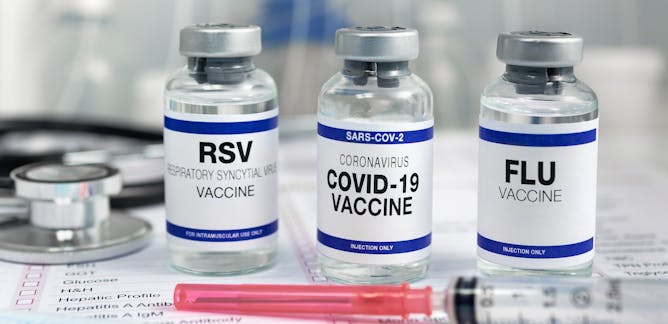|
|
|
|
The U.S. Environmental Protection Agency is expected to propose new greenhouse gas emissions standards for existing power plants this week, and one of the technologies getting attention is hydrogen as a power source. Hannes van der Watt, an energy scholar at the University of North Dakota, explains how hydrogen – the most abundant element in the universe – can be an ingredient for industry, a greener fuel for ships and potentially a way for natural gas electricity plants to keep operating under tougher emissions standards.
Frequent readers of this newsletter are likely aware of the burgeoning field of ancient DNA research. Scientists are becoming adept at sequencing DNA from people and other organisms that lived thousands of years ago. But an interesting study published last week took things a step further. A team of anthropologists, archaeogeneticists and biochemists sequenced billions of ancient DNA fragments from the microbes that lived in the tartar of a human’s tooth tens of thousands of years ago and then recreated the natural compounds encoded in bacterial genes. They hope their technique will let scientists hunt in archaeological samples for new – but old –
antimicrobial compounds that can help modern medicine.
And let me point you to three recent stories on our site that made me smile. A biologist penned what amounts to an ode to webbing clothes moths – click in to see why she loves the sweater-ruining pests that I personally want to annihilate. An environmental humanities scholar wondered about the internal motivations and experiences of a “vagrant” Steller’s sea eagle that’s exploring places thousands of miles away from home. And a
mechanical engineer weighed in on the Transportation Security Administration’s refusal to allow an airplane passenger to have more than 3.4 ounces of peanut butter in his carryon bag – the physics fits with the TSA’s ruling.
|

|
Maggie Villiger
Senior Science + Technology Editor
|
|

Ancient DNA preserved in the tooth tartar of human fossils encodes microbial metabolites that could be the next antibiotic.
Werner/Siemens Foundation
Christina Warinner, Harvard University; Alexander Hübner, Max Planck Institute for Evolutionary Anthropology; Pierre Stallforth, Friedrich-Schiller-Universität Jena
Ancient microbes likely produced natural products their descendants today do not. Tapping into this lost chemical diversity could offer a potential source of new drugs.
|

Hydrogen has potential, but it faces some big challenges, including a lack of pipeline infrastructure.
Petmal/iStock/Getty Images Pluss plus
Hannes van der Watt, University of North Dakota
Hydrogen is getting a lot of attention as the EPA prepares to propose new greenhouse gas emissions rules for existing U.S. power plants.
|

Tineola bisselliella can survive on as little as a hairball and some vitamin B.
Olaf Leillinger/Wikimedia Commons
Isabel Novick, Boston University
An appreciation for the moths that chomp holes in your clothes. They eat the inedible, occupy the uninhabitable and overcome every evolutionary obstacle in their way.
|
|
|

Adriana Craciun, Boston University
A Steller’s sea eagle, native to the Asian Arctic, has traveled across North America since 2021. A scholar questions whether the bird is lost – and how well humans really understand animals’ actions.
| |

John MacCormick, Dickinson College
One researcher’s experience from a quarter-century ago shows why bias in AI remains a problem – and why the solution isn’t a simple technical fix.
|

Annette Regan, University of San Francisco
The newly approved RSV vaccine could be rolled out by fall 2023, in time for the typical winter surge in RSV infections.
| |

Ted Heindel, Iowa State University
A mechanical engineer explains why you need to go with the flow. The TSA pronouncement that peanut butter is a liquid is scientifically sound.
|

Christine Nguyen, University of Southern California
The American Academy of Pediatrics has recently released new obesity management guidelines in order to help address the growing obesity crisis in children.
| |

Courtney Carignan, Michigan State University
Quaternary ammonium compounds, also known as QACs or quats, are commonly used antimicrobials also found in many household products. Soap and water may be a safer bet when cleaning surfaces.
|
|
|
|
|
-
Morgan MacLeod, Harvard University
Stars begin to expand when they run out of fuel and can become thousands of times larger, consuming any planets in the way. For the first time, astronomers have witnessed one such event.
-
Kyle B. Enfield, University of Virginia
There’s no one-size-fits-all approach for long COVID treatment, but exercise focusing on breathing and pacing yourself throughout the day often helps.
-
Seema Lakdawala, University of Pittsburgh; Anice Lowen, Emory University
From cancer immunotherapy and antibiotics to GMO crops and pandemic surveillance, gain of function is a cornerstone of basic research.
-
Eric C. Gaze, Bowdoin College
The idea that the least skilled are the most unaware of their incompetency is pervasive in science and pop culture. But a new analysis of the data shows that the Dunning-Kruger effect may not be true.
-
John Katsaras, University of Tennessee; Charles Patrick Collier, University of Tennessee; Dima Bolmatov, University of Tennessee
Pinpointing where memories are stored in the brain and how they are transmitted could provide new targets to treat neurological diseases and serve as models for neuromorphic computing.
|
|
|
| | |
| | |
| |
| |
| |
|
|
|